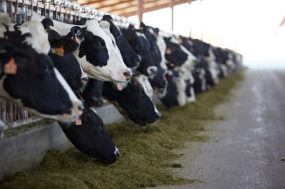“Feasibility of the use of deep learning classification of teat-end condition in Holstein cattle.” Journal of Dairy Science Vol. 104 No. 4, 2021.
This research, done by scientists from Cornell University, studied the development of a digital tool to assess the condition of cows’ teat ends. The authors say that infections with pathogenic bacteria entering the mammary gland through the teat canal are the most common cause of mastitis in dairy cows; therefore, sustaining the integrity of the teat canal and its adjacent tissues is critical to resist infection. However, they say, to date, routine assessment of teat condition is limited to cowside visual inspection, making evaluation a time-consuming and expensive process. Current industry guidelines recommend evaluating at least 80 cows, or a minimum of 20% of cows in herds larger than 400 cows.
Mastitis is one of the most frequently occurring diseases of dairy cows. A 2017 study estimated the average cost per clinical case of mastitis in the U.S. to be US$325, and a 2018 study in Canada estimated the cost of mastitis to be approximately US$500 per milking cow per year.
The authors indicate that machine milking, along with a complicated interaction of many factors, can have a substantial effect on the condition of the teat. These tissue alterations can be classified in short, medium and long term. Long-term changes are the adaptation of teat tissue to machine milking over several weeks or longer and result in increased teat-end callosity thickness and roughness.
This, in turn, affects teat canal closure, and consequently increases the risk of new intramammary infection. According to the authors, early detection of long-term changes is important, and frequent monitoring of teat-end callosity is therefore an important part of a mastitis prevention program.
To help address this problem, the authors propose a fully automated digital workflow based on the following steps: acquire teat images with sufficient quality, process the images, automate teat-end condition scoring and compute a herd-, or pen-, level prevalence of teat-end callosity. To test this system, they used a total of 398 digital images of dairy cow teats on two commercial New York farms. Both farms milked cows in rotary parlors. The images were taken with digital cameras on common cell phones, with no supplemental lighting.
The authors conclude saying that although this particular study had several limitations (namely the small data set), it is possible to use deep learning to classify teat-end condition through the use of digital images. Logistically, such a system could be most easily used in a rotary parlor, where a stationary camera would capture each individual cow from a single point in the parlor.
Another area where this technology can have a strong impact is in robotic milking facilities. They also refer that, other than static photos, a future area of research will be the use of video capture technology, since this may provide a more accurate assessment of teat-end condition compared to a static image, as the average result of many images taken from an individual animal could be used to create the classification.
“A retrospective study investigating the association of parity, breed, calving month and year, and previous parity milk yield and calving interval with twin births in U.S. dairy cows.” Journal of Dairy Science Vol. 104 No. 4, 2021. This study, from researchers from the University of Wisconsin, aimed to identify associations between milk yield and the prevalence of subsequent twin births in U.S. dairy cows using a large data set. The authors clarify that in this study, previous parity or lactation refers to the parity during which the cow would have conceived either a singleton or twin calves, and the birth outcome is the result of this conception; thus, the cow’s milk production is what she produced during the lactation during which she conceived.
Their main objective was to determine the association between milk yield during the lactation of conception and the subsequent twin birth risk. They also defined secondary objectives, namely to identify associations between:
- Twin birth and milk production in the lactation initiated by the twin birth event
- Twin birth and calving interval length following the twin birth event
- Twin birth and subsequent lactation twin birth prevalence
The authors explain that twinning costs the dairy industry an estimated $96 million each year. Twin pregnancy occurrence in high-producing dairy cows is primarily explained by the fact that these cows have a high feed consumption, which leads to an increase in liver blood flow, resulting in an elevated hepatic metabolism of progesterone and estradiol. The reduced circulating concentrations of progesterone and estradiol result in an increased multiple ovulation rate, which increases the twinning rate.
The data set the authors used included almost 2.9 million U.S. dairy calving and production records between 2001 and 2020. The variables considered were parity, breed, milk production, calving interval, calving month and year.
The conclusions of this study are very interesting, and the authors say they can be instrumental in guiding research focused on reducing twinning in lactating dairy cows. The data showed that twin birth probability increased for cows with increased previous parity milk yield independent of breed or parity. Third and greater parity compared with second parity, and all breeds compared with Jerseys, were associated with greater twin probability.
Calving between April and September that corresponded to conceiving in July through December was associated with greater twin birth probability. Twin births were associated with decreased milk production following the birth event in Holsteins and second parity cows and in the calving months between June and September. Surprisingly, the authors say, twin births in third and greater parity cows were associated with an increased 305-day milk yield. Cows that had a twin birth were more likely to calve twins in the subsequent parity and had a greater risk of having a calving interval between 413 and 600 days.
This column brings you information regarding some of the research being done around the world and published in the Journal of Dairy Science. The objective is to bring to light areas of research that may have an immediate practical application on a dairy farm, as well as research that, even though may not have a practical impact now, could be interesting for its future potential application. The idea is to give a brief overview of select research studies but not go into detail on each topic. Those interested in further in-depth reading can use the citations to find each study.









